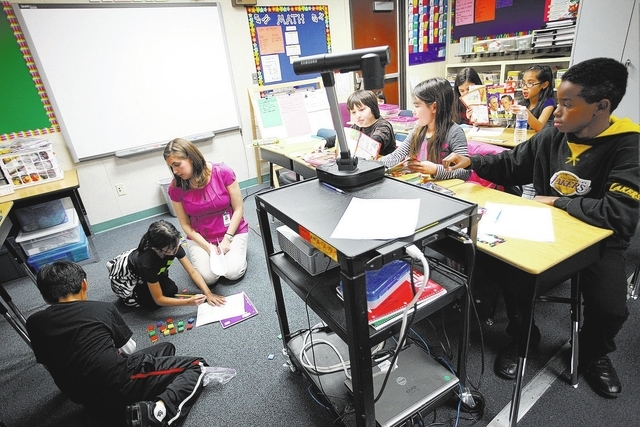39 schools face year-round schedules; 29 elementary schools off the hook
Clark County families at 29 elementary schools are breathing a sigh of relief, and not because their children will be back in school Monday after a two-week winter break.
Their children will remain on the traditional nine-month schedule next school year and not switch to year-round classes, according to a letter sent to them by the Clark County School District before winter break. Last fall, the families had been warned that was a possibility because of crowded conditions.
However, Superintendent Pat Skorkowsky sent a different letter to families at 39 other elementary schools with enrollments that exceed their capacities.
Those 39 schools may still go year-round in 2014-15, a costly change. Each year-round school costs taxpayers about $308,000 more to run each year, meaning it will cost $12 million to convert the 39 schools year-round watch list.
Crowding has become so severe at the district’s 217 elementary schools that officials are left with few options. Elementary schools are on average 13 percent over the student capacity of their permanent facilities, according to a head count on Nov. 18. The most crowded schools teach 88 percent more students than their buildings can hold.
Portable classrooms help. But the district already has 1,282 of those at its elementary schools alone. If pushed together, the portables represent nearly 40 additional elementary schools. Wynn Elementary School, east of Jones Boulevard and south of Sahara Avenue, has 18 portable classrooms.
Year-round scheduling gives schools the ability to accommodate about 20 percent more students by splitting them among five different tracks. Students still receive 180 days of instruction, with one track of students always on break.
With no more room for portables at many campuses, the district put three elementary schools – Forbuss, Reedom and Wright – on year-round schedules this school year.
That number could be multiplied by as many as 10 next school year. That decision will be made before April, Skorkowsky wrote.
Families at the 29 schools whose schedules are safe for now may soon find themselves facing a 12-month school year. They could be back on the watch list next fall, Skorkowsky wrote.
For the 29 schools taken off the watch list, their campuses are an average of 30 percent over capacity with 10 portables each. Those still on the list are on average 38 percent over capacity with 11 portables each.
The decision as to what schools would stay on the list wasn’t based on just student and portable numbers, said district spokeswoman Melinda Malone on Thursday. The superintendent looks at whether schools meet the district’s three triggers to go year-round, but also considers factors such as school performance and school-level feedback on crowding.
The three triggers: enrollment must require eight portable classrooms this year and be expected to do the same next year; student enrollment must exceed capacity by at least 25 percent for those two years; and the projected enrollment for next school year must represent a 5 percent increase over the average enrollment for the current school year and the preceding year.
Skorkowsky reviews the triggers and has the final say. He can switch schools that don’t meet the year-round triggers or keep schools on nine-month schedules even though they meet all triggers.
The 29 schools off the hook for 2014-15 are Bell, Crestwood, Culley, Cunningham, Ira Earl, Edwards, Fong, Gragson, Griffith, Harris, Keller, Lowman, Lynch, Manch, McWilliams, Mendoza, Ober, Park, Pittman, Red Rock, Reed, Ronnow, Rundle, Scott, Hal Smith, Snyder, Squires, Ullom and Wolff.
Contact reporter Trevon Milliard at tmilliard@reviewjournal.com or 702-383-0279.






















